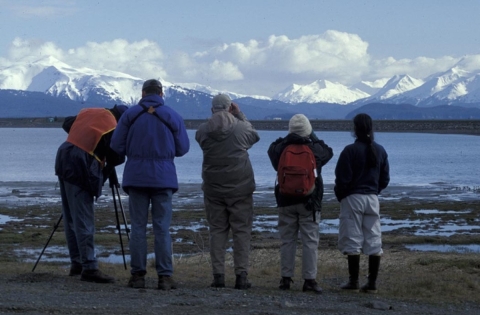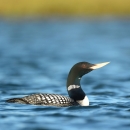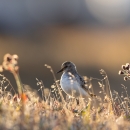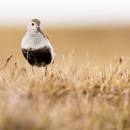States
AlaskaEcosystem
Tundra, WetlandOverview
The breeding season of migratory shorebirds’ life is just one piece to the conservation puzzle. What happens during a species’ migration and on their wintering grounds can affect their ability to survive and reproduce on their breeding grounds. However, we still need to better understand how shorebirds migrate, where and when they stop for rest, and generally how populations interact with each other outside of their breeding ranges. Recent updates in tracking technology have made it possible to study small-bodied wildlife, like shorebirds, as they move throughout the year. By attaching state-of-the-art tracking devices, we can learn when and what habitats individual birds, and by extension populations, depend upon as they travel between breeding and winter locations. Furthermore, understanding potential threats facing shorebirds requires knowledge of where they are throughout the year.
During this study we have tracked Dunlin, Semipalmated Sandpiper, Buff-breasted Sandpiper, American Golden-Plover, Red Phalarope, Pectoral Sandpiper, Stilt Sandpiper, Surfbirds, and Whimbrel. This is a highly collaborative project: our success is only made possible by the support and involvement from our numerous partners: Arctic National Wildlife Refuge, Manomet, Wildlife Conservation Society, University of Alaska Fairbanks, and Environment and Climate Change Canada and others. These data are also used by the Shorebird Science and Conservation Collective, a program that combines tracking data from shorebird researchers with other data (e.g., eBird, surveys) throughout the Western Hemisphere to locate “super hotspots” (places where multiple species overlap in time and space) and then collaborate with landowners and managers to inform real-time conservation and ensure these important habitats are reliably available for shorebird use.
Importance of this Work
Many Alaska-breeding shorebirds are declining and face imminent threats that can only be resolved by a holistic approach that involves their entire annual cycle. In addition to understanding a species' breeding ecology, we must also learn know where and when species migrate and how they use their wintering areas. For many species of shorebirds, we lack this information, knowing very little about where a bird travels after it finishes breeding. However, the development of light-weight tracking devices provides a unique opportunity to know a bird’s location very accurately throughout the whole year. These locations reflect habitat preferences in an unbiased way and can then be geo-referenced with landscape features to determine local threats. Once this information is known, conservation actions can be targeted at these sites rather than guessing where conservation funds should best be spent.
Actions WE ALL can take
Giving them Space. Beach/coastal walking, a seemingly harmless activity, can have negative consequences on shorebirds that are using the area for rest, foraging, or nesting. In some parts of the U.S., human disturbance is one of the most significant threats to shorebird populations. These threats can intensify as human use (coastal recreation, off-leash dogs) in these coastal areas increases, leading to an overall reduction in suitable, undisturbed habitats for shorebirds.
If you are recreating near a coastline, shoreline, or other wetland type used by shorebirds, please give the shorebirds space—ideally, do not approach within 200 m (656 ft.). If you are recreating with a dog, please keep your dog leased, as the presence of dogs is directly related to shorebirds expending more energy being alert to their presence. If you are located in Anchorage, the municipal law requires you to restrain your dog in public places unless you are in a designated off-lease dog park. Learn more about how leashing your dogs protects birds from the National Audubon Society.
Participating in citizen science. Anyone can contribute valuable data by submitting what they see to citizen science programs like eBird or becoming an International Shorebird Survey volunteer. Shorebirds lend themselves to being quite visible outside the breeding season, congregating in large flocks and utilizing visible habitats like beaches and shorelines. Casual bird sightings can be a valuable data points for scientists. By submitting your bird sightings to eBird, or participating in the International Shorebird Survey you can play a crucial role in helping scientists monitor shorebirds.
Spreading the Word: Share information about shorebirds and their threats with your family, friends, and neighbors. Talk to them about how sustained public support are crucial to ensure the future of this group of birds.











